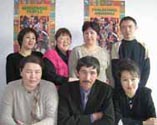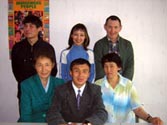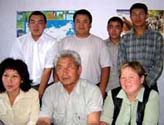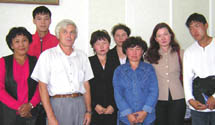United Bulletin
of interns of groups 1, 2, 3 and 4
 |
 |
 |
TABLE OF CONTENTS
Indigenous Peoples of Altai: Tubalars and Telengits
Telengits of Kosh-Agach Region
According to the results of Population Census of Russia in 2002 in Russian Federation there were 3 thousand Kumandins, 3 thousand Telengits, 3 thousand Teleuts, 2 thousand Tubalars, 0.9 thousand Chelkans, 17 thousand Shor people, 67 thousand Altai people, 655 thousand Kazakhs and 115896 thousand Russians.
THE TUBALARS OF TUROCHAK REGION
Altai Republic is a wonderful picturesque spot on the globe. It is one
of the rare places where the nature is still primordial. On its territory
there are lots of clean rivers, lakes, silver springs, forests and mountains,
glaciers which don't melt in summer. Altai has very rich fauna, diversity
of animals. All these things together let the people who come here for
rest and local people admire the beauty of nature and breathe fresh air.
In our industrial century fresh clean air is not everywhere.
Altai Republic is multinational. The Tubalars are one of its indigenous
ethnic groups. According to the latest data of population census there
are 2000 Tubalars in Altai Republic. These people live on banks of the
Teletskoye Lake since ancient times. On the right side of the lake there
is Artybash village, on the left side - Iogach village, both villages
are connected with a bridge. The Tubalars have saved their culture, customs,
traditional activities: fishing, hunting, agriculture, picking officinal
herbs, handicraft.
But for the last decades all the subjects at school are taught in Russian.
Russian and German languages are compulsory, but they don't teach in Tubalar
language. Tubalar language is in danger of disappearance. In nurseries
and kindergartens there are no groups where children are educated not
only in Russian but in their native Tubalar language. We all understand,
if the language is lost, the culture will be lost. Like natural law of
minority swallowed up by majority.
That's why we have an idea to establish Tubalar Center which would have
an exhibition hall showing artifacts, national dresses, souvenirs, literature
on Tubalar culture, customs, traditions and lifestyle of Tubalar people.
The building should be spacious and light, and teacher of arts should
work there with children teaching them ethnic dances and songs, national
plays. In this way the small indigenous group could have the possibility
not only to save their culture but to show it to other people. At present
Altai is subsidized republic, and how long it will continue we don't know.
If anybody wants to help us in this charity - creation of the Center -
please, reply.
About international organizations for rights of indigenous peoples of
the world and about the decade of indigenous peoples I've learned only
here during the interns' courses in Gorno-Altaisk. It's so good that there
are people who could found the Information Center where indigenous peoples
can learn international, federal and regional laws concerning their rights
and claim them.
In Turochak Region the land problem is very actual for a long time. During
Head of the region N. Boltukhin's managing lands have been sold and are
still being sold, this man never considered local people's opinion. He
has sold helicopter ground. But he'd better earn money with his brains,
not by selling people's lands, he must feel ashamed for that. At the same
time on Artybash Administration desk there is a pack of applications from
indigenous population of the village asking about lands for houses constructing.
And it's painful to talk on what is happening on our lake. Many rich people
use the lake as a source for profit. They have brought many boats and
take tourists aboard for a walk. The boats are old, they are painted right
here, as usual they don't meet sanitary requirements and make irretrievable
harm to the Teletskoye Lake. The boats are filled anyhow anywhere all
the summer, the lake is covered with big spots of fuel and lubricants.
Most of the boats are not legal. And the Head of the region N. Boltukhin
doesn't care. Probably he agreed with the owners of the boats leaving
poisoned water for local people, he himself doesn't drink it. He leaves
the Teletskoye Lake to die despite it is called the World Heritage.
Ludmila Kydatova, Tubalar
2 thousand meters above sea level on the
crossing of four state borders (Russia, Mongolia, China and Kazakhstan)
Telengit people live. They are the people who have been keeping carefully
their original culture and language, traditions and customs of the ancestors
for centuries. The land where they live they call with love 'Ere-Chui'.
Telengits like their fathers worship to the Earth, the Sky, spirits of
Ancestors, Water, Fire, Mountains, they ask them about forgiveness and
blessing. They worship to the Highest God - Altai Kudai, who gave life
to everything in the world. And all these spirits and Gods have holy aureole
- sacralness. From generation to generation Telengits have been creating
their philosophy comprehending the secrets of the universe, living in
harmony with the Nature, being a part of it.
Telengits are devided into 'seoks' - clans, and each seok has its sacred
mountain and totem. For example, clan of Sagals have Sailugem-Iyik, Koboks
have Kok-Iyik, Mools - Irbistoo, etc.
With the beginning of technical civilization Telengits are loosing their
connection with land. The animals they were hunting are exterminated,
fish and birds are disappearing, forests are being cut down. Thousands
of hectares of land were ploughed and abandoned after the USSR disintegration,
now only stones are left on these places. Hundreds of tumuluses are dug
out, hundreds of stone graven images are brought out. Some time ago they
were a striking part of the landscape, now profaned they are lying under
sand and wormwood.
Telengits have never disturbed rest of ancestors, they tried to avoid
such places. Even now they don't visit without necessity the places where
the bodies of those who went to the other world are buried.
Telengits consider the defilement of nature and their historical past
is the reason of suicides, which became frequent especially among youth,
and of nature cataclysms. The connecting thread is broken, the harmony
between the Man and the Nature is destroyed, as result sacredness of the
environment is lost and inner values that formed during many thousands
years are lost.
People who think they are more educated than Telengits in the field of
ecology and other sciences consider such explanation with irony. But it
is worth thinking about, our ancestors were wiser us, that's why from
generation to generation they passed the knowledge given them by Nature.
If we loose our connection with nature we will loose our originality and
will become "mankurts".
Collective farms are destroyed, this caused mass unemployment. In the
villages most of the families live off children allowances and gardening.
Young strong men are not busy because they cannot find a job as there
is no manufactures. According to the latest statistical data the average
life length of men in the region is 37 years. Kosh-Agach Region is one
of extremely uncomfortable for living regions.
By its severe climate Kosh-Agach Region is included in the list of places
which have conditions equal to North territory. Only north subsidies help
us to live, and this is the only significant assistance that Telengits
of our region receive from the government.
Maya Erlenbayeva, Telengit
On the way to the UNESCO World Nature Heritage,
the famous Teletskoye Lake, in 140 km away from the center of Altai Republic
Gorno-Altaisk city there is a village called Kebezen'. From Altai language
its name is translated as "Hello, boat!", 'kebe' means "a
boat" and 'ezen' - "hello".
Kebezen is one of the big villages of Turochak Region. There live Tubalars,
Kumandins, Russians and very few people of other nations. In the village
we have a 2-floor school built of bricks, a House of Culture, Practitioner's
and Obstetrician's Center, some private shops and saw-mills, one private
bakery. The village consists of two parts: Kebezen and Upper Kebezen (we
call it 'Stariy (old) Kebezen'). I will tell you about Old Kebezen where
I was born. Old Kebezen is located 1.5 km away from the center of the
village. This part of the village is surrounded with high mountains covered
mostly with conifers: cedar, pines, firs; and when autumn comes on the
green backgrounds there are bright coloured spots of aspen, guelder rose,
rowan-tree, birch. In winter time local people prepare birch-bark for
lighting stoves and firewood of birch which are considered the hottest.
On the outskirts of the village there runs a small river Kebezenka. Petty
fish abound in this river. During the spring flood it becomes rapid, turbid
and demolishes everything on its way.
Our forests are rich with diversity of berries: wild strawberry, bilberry,
raspberry, cranberry, black and red currant, red whortleberry, blackberry,
guelder rose; the names of mushrooms and especially officinal herbs are
endless. Among wild animals here are wolves, bears, foxes, hares, musk-deer,
squirrels, etc.
In the Soviet period the greatest part of the population worked in a collective
farm. The farm was not prosperous, but the people were employed and got
salary. In early 90ties a fire killed most of the milk cows. After that
the farm didn't exist any more.
We also had industrial wood processing forestry. After the collective
farm and the forestry had finished their work, part of the property, lands,
equipment were divided among former workers and pensioners. Many families
moved to other regions. At present the greatest part of population of
the village live owing to the children allowances, pensions and gardening.
Mass unemployment prevails in this place now. Only pensioners have more
or less stable income, they get pension from the State. Youth are not
in demand and they become drunkards. But among them there are many talented
guys. The interest to the higher education is growing, but only very few
can leave for study.
We always have had the problem with water. There is an old well which
freezes in winter, and every spring dirty water from puddles floods it.
For drinking water we have to go to the edge of the village and walk down
the steep clay slope of ravine. The water that doesn't meet sanitary standards
can cause intestinal diseases.
Every spring the local people go for earnings to taiga to the collectors
of fern. They pick fern by whole families. This work is hard and low paid,
but they don't have other choice.
We are not lucky with our Head of the village. Before taking this position
people promise a lot but the results are deplorable. Each of them succeeds
only in his personal purposes. And these people have always lived with
us...
Irina Solodukha, Tubalar
Every year territory of Altai
Republic is visited by many guests, tourists, and when they see on a pass
on lower tree branches lots of tied cloth ribbons they do the same without
any sense. I want to tell about the custom of worship to a mountain.
Altai people are tightly connected with the nature. They revere a nature
as a living man and believe that every object in nature has its master
- a Spirit. In Altai people's notion the world is divided into three parts:
the upper level - God Ulgen, the medium level - ground surface, the underground
level - Erlik.
Indissoluble connection of a man with nature, its animation made a man
dependent on nature and instilled fear of powers of nature. Some failures
of a man made his dependence on nature even stronger. Each of Altai peoples
has its own mountain: Tubalars' mountain of worship is Choptoo, Cusens'
one is Solog, etc. Worship to a spirit of a mountain is widely spread,
and tying up the white ribbons on the passes is connected with it. These
ribbons were tied up in certain places, as in ancient time every traveller
knew which way he would follow, past what mountains and passes, and prepared
these ribbons beforehand. The ribbons (d'alama) must be tied up in a proper
way. Nowadays, when rituals, traditions and beliefs are being revived,
the white ribbons are tied up everywhere. Some people do it in accordance
with certain rules which they know, but some just imitate what they see.
For a long time in ritual of ribbon tying people differ two terms: kiyra
and d'alama. Altai people tied up the white ribbons not only on the passes
but also at the springs (kara-soo, arjan-soo) which are not frozen in
winter and are considered to be healing and the places of their location
to be sacred; also at the places where juniper (archin) grows. The main
purport of the ribbon tying ritual is that the man swears to keep Altai
nature, traditions and customs of the people and keep loyalty to the people.
Tying the ribbon, the man asks his Altai, Altai Master (Altai Aazi) to
be gracious to him. By this ritual the man expresses his love to Altai
nature. There are certain rules which must be known and observed by everyone
tying a ribbon: the ribbon must be of new white cloth. While tying a male
must take off his head-dress, no laugh must be there during the ceremony,
a man who is tying a ribbon must express his wish, his request to the
Master of the mountain, ask him about a good journey, safety and health
and tell the desire:
My Altai is with the Moon,
The Sun and the Sky.
With forest and taiga.
Heating and shining Sun,
Raising full and bright Moon,
I ask you to bless me,
Take misfortune away from my way,
Let my people be lauded,
I am grateful to you, my Altai.
The ribbon is tied to the branch with one
knot carefully so that not to damage the branch bark. After tying the
performer must turn to the East and bend staying on his knees and extend
both his hands forward or only the right hand.
There is nothing indecent if you only tie the ribbon without bending.
In sacred places nobody can speak loudly, use foul words or brawl. Those
who do not observe the rules will be punished by nature themselves or
their family and close people. Those who tie coloured, striped or black
ribbons are considered to worship Erlik - the Master of the other world.
If you haven't prepared a ribbon you'd better not tie anything, there
is nothing bad in it. If you don't have a white ribbon, you can use a
monochromatic yellow, green, blue or red one. The white colour is devoted
to the Master of Altai, yellow to the Sun and steppes of Altai, blue to
the sky, red to the fire and green to the fields and forests of Altai.
A tree with white ribbons must not be cut, its branches must not be broken.
All the gifts and riches of Altai serve the man and the man uses them,
keeps and protects Altai.
Irina Solodukha, Tubalar
My village Balyktuyul' is one of the biggest
villages in Ulagan Region of Gorny Altai. The population of the village
is more than 2.5 thousand people. 2 km away from my village there are
world known Pazyryk Tumuluses of ancient skifs. The name of the village
comes from the Telengit words 'balyk' - fish and 'tuyul' - river. Old
inhabitants of the village say that some time ago there was so much grayling
fish in the river that after floods children picked graylings from the
ground. But now owing to the ecological situation the fish became small
in size and in amount.
This river is the only source of clean water for household needs. In winter
time the river is covered with thick ice up to 5 meters. The ice comes
up to a sheep-fold and toilets, and in spring this water carries away
all the waste into river, goes into the Ulaganchik River, Bashkaus River,
Chulyshman River and to the Teletskoye Lake. From the Teletskoye Lake
the river Biya begins which together with the Katun form the beauty of
Siberia - the Ob' and run into the Karskoye Sea. So, we can conclude that
all the infections from our village that get into our river infect with
different intestinal diseases almost all Siberia.
But there is a solution for the villages how to provide people with clean
drinking water - making wells and water-pumps. This would also help to
get water safely in winter time, because ice-hole 5 meters in depth on
the river is dangerous and not acceptable for everyone. And in spring,
when the level of water goes up and the ice is melting it's very risky
to go on the river.
Deputies of regional Councils, Head of the village Administration, officials
of sanitary and epidemiological stations must urgently solve this problem.
Such situation of the village inhabitants has not improved for decades.
Marina Konunova, Telengit
